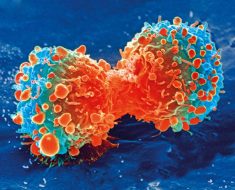
There are a number of ways to attack cancer; one of the most commonly used is radiation therapy.
Radiation works on tumors in two ways; firstly, it damages DNA and, secondly, it produces oxygen radicals that also harm cancer cells.
However, when oxygen levels are low (hypoxia), the body produces fewer oxygen radicals, meaning that radiation therapy is less effective.
Because cancer cells divide so quickly, they require more oxygen than healthy tissue. At the same time, blood vessels within tumors are often poorly constructed, making them less efficient.
This means that cancer cells often run out of oxygen, making radiation therapy less deadly to cancer.
Similarly, these dead, hypoxic zones in the tissue, where blood supply is limited, are difficult for drugs carried in the blood to reach. In this way, hypoxia can reduce the impact of both radiation therapy and chemotherapy.

Can we get around hypoxia?
The author of the current study, Dr. Nicholas Denko, Ph.D., explains why hypoxia is such a problem in cancer treatment: “We know that hypoxia limits the effectiveness of radiation therapy, and that’s a serious clinical problem because more than half of all people with cancer receive radiation therapy at some point in their care.”
Dr. Denko continues, “If malignant cells in hypoxic areas of a tumor survive radiation therapy, they can become a source of tumor recurrence. It’s critical that we find ways to overcome this form of treatment resistance.”
In his search for ways to improve radiation therapy, Dr. Denko and his team came across a drug called papaverine. Currently, papaverine has a variety of uses, none of which have direct links to cancer.
For instance, papaverine can be used to reduce muscle spasms and to treat erectile dysfunction.

Papaverine works by inhibiting respiration in mitochondria, the fabled powerhouses of the cell. Dr. Denko and his team found that by blocking the activity of oxygen-consuming mitochondria, they could make tumors more sensitive to radiation therapy.
They showed that one dose of papaverine before radiation therapy reduced mitochondrial activity, thereby limiting hypoxia and enhancing the destruction of tumor cells.
Earlier attempts to address the hypoxia problem have focused on adding more oxygen to the tumor. This study takes the opposite approach, by reducing the oxygen demand.
Importantly, the drug did not make healthy tissue more sensitive to radiation therapy.

The future of hypoxia
These findings were published recently in the Proceedings of the National Academy of Sciences. In an associated commentary in the same issue of the journal, the authors write:
“It is well established that hypoxic cells are two to three times more resistant to radiation than aerobic cells […] [This research] represents a potential landmark in the 6-decade-old quest to eliminate hypoxia as a cause for radiotherapy treatment failure.”
This is far from the end of the road, though. The researchers hope that by adjusting the structure of papaverine, they might be able to enhance its benefits further. By tinkering with its makeup, they might potentially reduce side effects, too.
Although a great deal more work will be needed before this intervention comes into wider usage, it is an exciting finding. It is a relatively simple process, using a well-tested drug that might help boost the performance of existing cancer treatments.
Source: Read Full Article





